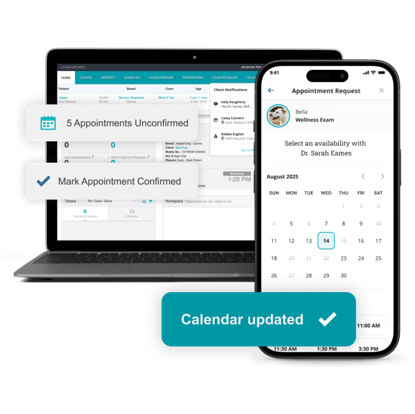How to Educate Veterinary Clients on The Value of Pet Preventive Care

Convincing pet owners that their seemingly healthy dog or cat needs a wellness check, screening test, or parasite prevention can be a hard sell. When their pet is bouncing off the walls or curled up peacefully on the couch, clients may wonder if a vet visit is worth the time or money.
Veterinary professionals understand the importance of pet preventive care, but pet owners may not. You can help them see the value of preventive care through client education that emphasizes the peace of mind, improved quality of life, and better long-term health that early detection can facilitate. Here are education strategies you can use to help clients understand the power of pet preventive care.
Educate in the exam room
The exam room is ideal for veterinary client education, offering face-to-face time with pet owners. Encouraging veterinary technicians and other team members to discuss preventive pet healthcare protocols during puppy, kitten, and young adult visits helps to normalize care plans with diagnostic testing, heartworm prevention, parasite control, vaccines, and routine blood work.
Use handouts and other educational materials to reinforce your pet preventive care recommendations and plant the seed for discussions during future visits. Personalizing the benefits of routine care and early detection by addressing common breed- or lifestyle-based health risks and ailments can help ensure this education has a more significant impact.
Provide real-life examples
Nothing drives home a message like a relatable story about the benefits of preventive care. Sharing real cases your veterinary team has encountered—especially where routine diagnostics helped detect a hidden health issue and enabled earlier interventions—can make recommendations feel more tangible to the average pet parent, who might not understand possible problems that could affect their pet’s well-being.
For example, talk about diagnosing anemia thanks to pre-surgical blood work or detecting heartworm disease after repeatedly testing a rescue pet from an endemic area. Or, share with cat owners how you’ve diagnosed early-stage kidney disease by establishing a pet’s baseline values and monitoring trends over several years.
Lean on veterinary team members
Educating clients about pet preventive care is a responsibility the entire veterinary team must share. Train team members, including CSRs, technicians, assistants, and veterinarians, to include messages about routine care, wellness plans, and animal health care services in everyday interactions.
For example, CSRs can remind clients about services and their value when they call to schedule, veterinarians can share why pet preventive care services are important for a companion animal’s lifestage and individual health risks, and technicians and assistants can provide handouts and answer questions while wrapping up a visit.
Educate beyond the clinic
Repetition is crucial in helping pet owners understand the importance of preventive care. Social media posts, client-facing platforms or apps, blog posts, and newsletters sharing consistent messaging ensure clients hear the same recommendations more than once and have a better chance of remembering them.
Educational posts about wellness services can catch clients’ attention, especially when paired with cute pet photos, short videos showcasing team members or real-life cases, or easy-to-digest infographics. Try creating monthly themes or building them from existing awareness days, such as senior pet veterinary care, heartworm prevention, or dental care. You can also point clients toward reputable resources, like AAHA or AVMA, that validate your protocols.
Leverage wellness plans
Wellness plans can help bridge the gap between what pets need and what clients can afford. A wellness plan bundles services required to provide a complete preventive care protocol into one purchase with manageable monthly payments, often with a built-in discount. When you choose a cloud-based, modern practice management software system, you can manage wellness plans right from your main dashboard.
Showing clients the differences between purchasing services a la carte and in a bundle and highlighting the convenience of having their pet’s wellness care mapped out can convince them to sign up. Pre-purchasing and offering additional visit discounts can motivate clients to get their money’s worth and bring pets in more frequently.
Driving home the value of preventive pet healthcare
Educating pet owners on the value of preventive care is an ongoing process you should aim to weave into every clinic touchpoint, including in-person visits, marketing and reminder emails, online booking, and social media or blog posts. Focusing on early diagnostics and routine wellness through consistent messaging and bundling services to provide better value helps clients understand and agree to preventive care recommendations.
Want more content like this?
Sign up for The Connected Practice Newsletter




